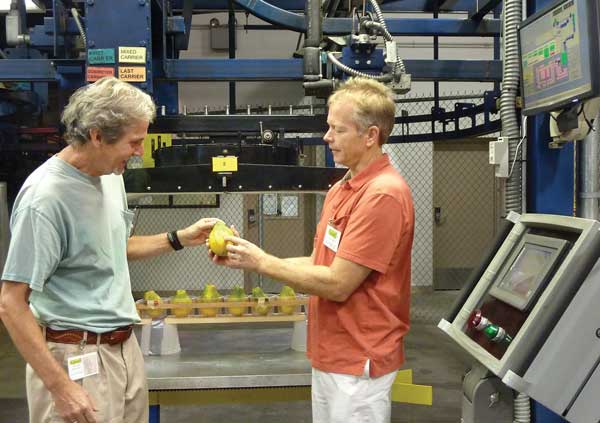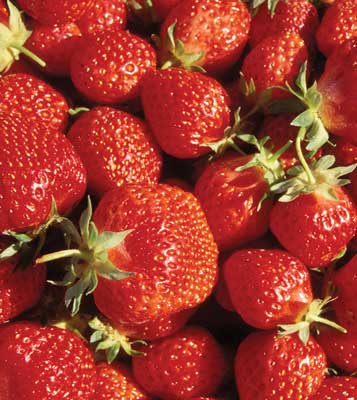Illuminating E-Beam Processing
PROCESSING
This month’s Processing column will explore electron beam (e-beam) processing. E-beam processing uses a low energy form of irradiation and has emerged as a highly promising treatment for both food safety and quarantine purposes. It is also used to extend food shelf life. This column will review basic principles and applications of e-beam processing. Special thanks to coauthor Lindsay Carswell, manager at ScanTech Sciences, Atlanta, for her contributions to this column.
Food Irradiation Overview
Food irradiation is the process of exposing food commodities to controlled amounts of low-energy ionizing radiation. The process destroys insects, molds, fungi, bacteria, and pathogens that cause foodborne disease and food spoilage. The process is gentle enough to maintain the quality of the treated food. Food irradiation is used for pest control, pathogen control, and extension of shelf-life. There are three types of food irradiation: x-ray, gamma ray, and e-beam.
The Food and Drug Administration (FDA), U.S. Dept. of Agriculture (USDA), and World Health Organization (WHO) have approved the safety of irradiation for treatment of a wide range of foods, including spices, meats, poultry, shellfish, fruit, vegetables, nuts, grains, and other products.
Food irradiation is approved for use in more than 40 countries with approximately 500,000 metric tons of food irradiated annually. The global market of services for irradiation processing of foods in 2012 exceeded $2.3 billion and is projected to grow to $22.5 billion by 2030. According to Food Safety News, about one-third of the spices imported into the United States are irradiated. There is no risk of radioactivity in irradiated foods due to the fact that the irradiation doses used are too low to induce radioactivity. FDA requires the use of the Radura international symbol of irradiation on foods. Foods that are not entirely irradiated do not require this labeling.
E-Beam Processing Advantages
E-beam processing has many benefits when compared with other forms of food irradiation. It uses electron beams that have been accelerated to near the speed of light. Commercial electricity is the source of energy. For this reason, e-beam processing does not require the shipment, handling, storage, or removal of any radioactive materials. Furthermore, electron beam equipment can readily be turned on and off, resulting in the presence of radiation only when the system is turned on. Any variation in dosage levels occurring during a processing run immediately shuts down the electron beam system, a capability not available with radioactive sources of irradiation. Another advantage of e-beam processing is that it employs a highly focused and precise beam of electrons that can be adjusted based on the size, density, or packaging material, enabling application of precise dosages. One of the disadvantages of e-beams in comparison to other forms of irradiation is their limited penetration depth. The penetration depth is dependent on a number of properties of the food and must be tested when applying this process. If needed, two opposing beams can be used to treat food products that are twice as thick.
Another advantage of e-beam processing is that food products normally only need to be exposed to the e-beam for mere seconds, while gamma and x-ray processes require hours of exposure. The shorter exposure time results in less material degradation compared with gamma and x-ray irradiation. In addition, e-beam processing can be performed in final retail packaging, thus improving supply chain efficiency. E-beam processing also enables the cold chain to be maintained as it generates no heat and does not require the product to be out of temperature specifications. Thus, the process is frequently called cold pasteurization. Finally, cold pasteurization results in less damage to fresh foods because ripening processes are not accelerated by temperature changes.
Electron Beam Processing Equipment and Applications
There are three basic components of an e-beam machine. An electron gun (consisting of a cathode, grid, and anode) is used to generate and accelerate the beam. A magnetic optical system is used to control the way that the e-beam impinges on the material being treated. This system typically consists of a magnetic focusing lens and a magnetic deflection coil. The lens is used to control the focus of the beams and the deflection coil is used to position the beam, frequently in an oscillating manner. A high-speed conveyor carries cartons of product to be sterilized. The e-beam machine operates as a multi-stage electron accelerator generating a dense beam of high-energy electrons that are showered across the target food, providing saturation of the target with electrons. As the food products pass through this beam, they absorb energy. Commercial e-beam accelerators emit energy ranging from 3 million electron volts to 12 million electron volts.
Current equipment manufacturers include ScanTech Sciences Inc., Atlanta; GrayStar Inc., Mt. Arlington, N.J., IBA Industrial Inc., Edgewood, N.Y., Russia-based Tecleour; Ebeam Technologies, Switzerland; Mevex, Canada; Iotron Industries, Canada; and others.
Food irradiation has been in use since the 1920s, when French scientists first discovered that irradiation could preserve food. Since then, food irradiation has been used for three main applications: quarantine, food safety, and shelf-life extension.
Quarantine - Disinfestation
Low-dose irradiation can be effectively used as a chemical-free quarantine treatment to control insects in fresh fruit, vegetables, and grains. Irradiation can replace dangerous fumigants like methyl bromide, a known carcinogen and ozone depleter. It can also replace hot water treatment of tropical fruit, a process that improperly handles the fruit by taking it out of temperature specifications. It has been demonstrated that low dosages of ionizing radiation, between 0.15–0.3 kGy, will very effectively control fruit fly and other insect problems. This makes the use of radiation for quarantine treatment very practical. The irradiation process is highly desirable because it leaves no residue on the food and is the only phytosanitary option that is 99.99% effective.
 One example of the successful implementation of e-beam processing was implemented through a collaboration between the USDA Agricultural Research Service in Hilo, Hawaii, and Hawaii Pride LLC. This novel process was employed to treat papaya, rambutan, longan, sweet potato, and other fruits and vegetables for export. In 2000 the first commercial irradiation facility dedicated to treating fresh produce for export was built by Hawaii Pride LLC (later purchased by Calavo Growers). This process was a technology transfer success and significantly enhanced export sales of these important and healthy foods, supporting Hawaiian growers.
One example of the successful implementation of e-beam processing was implemented through a collaboration between the USDA Agricultural Research Service in Hilo, Hawaii, and Hawaii Pride LLC. This novel process was employed to treat papaya, rambutan, longan, sweet potato, and other fruits and vegetables for export. In 2000 the first commercial irradiation facility dedicated to treating fresh produce for export was built by Hawaii Pride LLC (later purchased by Calavo Growers). This process was a technology transfer success and significantly enhanced export sales of these important and healthy foods, supporting Hawaiian growers.
Food Safety
Irradiation breaks down microorganisms such as pathogens. It also slows down the ripening process by killing bacteria that spoil food. This can result in fewer outbreaks of foodborne illness. Since irradiated foods have fewer bacteria and pathogens, they are safe for immune-suppressed hospital patients to consume. This benefit has led NASA to use irradiation for astronaut food to reduce the likelihood of foodborne illness. The process does cause nominal nutrient loss in some foods roughly equivalent to the nutrient loss that occurs when foods are normally cooked. Omaha Steaks, Omaha, Neb., irradiates its ground beef to prevent risk of pathogenic E. coli and Salmonella.
 Shelf-Life Extension
Shelf-Life Extension
Low-dose irradiation treatment inhibits the sprouting of vegetables such as potatoes, onions, and garlic. In addition, low-dose irradiation delays ripening and thereby extends the shelf-life of some fruits, including strawberries, bananas, mangoes, papayas, guavas, cherries, tomatoes, and avocados. As documented in tests conducted by the University of Tennessee and Iowa State University, the irradiation process can add as much as 30 days to the shelf life of certain seafood and 14 to 15 months to the shelf life of potatoes. The FDA reports that irradiated strawberries remain unspoiled for up to three weeks compared with three to five days for untreated berries. The longer shelf life of these products can extend their marketability as well as the distribution distance to market for these products.
Future Developments
Food processors are eagerly seeking new safe, effective methods for phytosanitary control, pathogen control, and shelf-life extension. Electron beam processing is a non-nuclear, quick, effective, cost-efficient solution that has great potential. While e-beam processing is not yet widely used commercially, it has the potential to completely replace less desirable quarantine treatments, including chemical fumigants, hot water treatments, and nuclear irradiation. Hurdle processes incorporating e-beam processing in combination with microwave or infrared processing are anticipated to be developed in the future to meet the full spectrum of needs in processed foods. Clearly the future is bright for this exciting new technology.
 Tara McHugh, PhD, Contributing Editor
Tara McHugh, PhD, Contributing Editor
Research Leader, USDA Agricultural Research Service, Albany, Calif.
[email protected]
Lindsay Carswell, is manager at ScanTechSciences, Atlanta ([email protected]).


